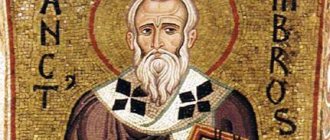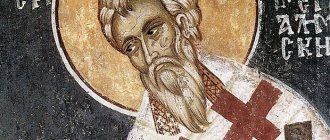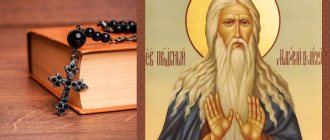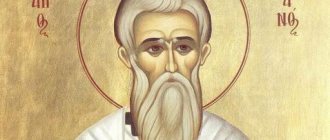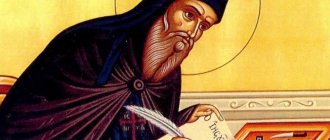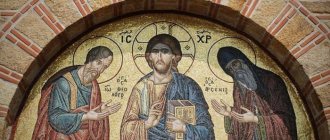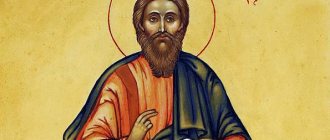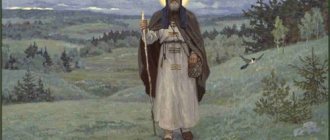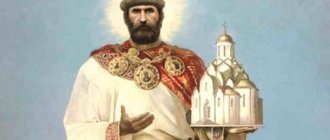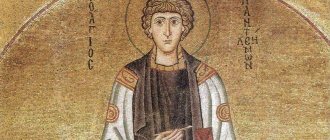Memorial Day: June 15(28)
Little is known about the first years of the life of Blessed Hieronymus of Stridon. Time has covered in oblivion the exact date of his birth, and even his worldly name (however, there is reason to think that his name was Eusebius). Jerome's birthplace is Stridon (a small town located near the borders of two regions: Dalmatia and Pannonia). Jerome's parents were Christians. There is a version that, according to their social status, they belonged to the ranks of wealthy freedmen.
Jerome received his initial education under the guidance of a teacher at home. Then, at the behest of his parents, he went to Rome, where he continued his studies. Among other educational disciplines, he studied philosophy and eloquence. During his stay in Rome, he experienced many temptations, which he did not always overcome. With all this, he managed to preserve that spark of faith that his mother and father lit in his heart as a child. On Sundays, for example, he loved to visit the tombs of Christian martyrs, the impression from which touched his soul so much that, according to his personal admission, it seemed to him as if he himself, alive, was going to the grave.
While in Rome, Jerome decided to change his life. Presumably, during this period he was baptized. Upon leaving the eternal city, while traveling through Gaul, he seriously thought about monasticism. Returning to his native Stridon in 372, Jerome no longer found his parents alive. The need to take care of his sister and younger brother, as well as his parents' inheritance, forced him to postpone his plans to become a hermit. For some time he lived in Aquileia, communicating with his comrades in the “semi-monastic” circle. Then he took a trip to the East, intending to visit Jerusalem, Syria and Egypt. However, upon reaching Antioch, he fell seriously ill.
After recovery, he settled in the Syrian Thebaid; believed to be in a local monastery. He lived there, in labors and prayer, for about five years. At the same time, he studied the Holy Scriptures and the Hebrew language. In Antioch he joined the community of Bishop Paulinus and was ordained a priest. After a short time, he moved to Constantinople, where he had communication with two great saints: Gregory of Nazianzus and Gregory of Nyssa. Leaving Constantinople in 381, he headed to Rome. At this time, a Council was held there, organized on the occasion of the Meletian schism. In Rome, the blessed father was awarded the position of secretary under Pope Damasus.
Not everyone accepted the highly spiritual life of Father Jerome: for many he served as a reproof. They began to intrigue against the saint. Slanders rained down. To all other accusations was added the accusation of sympathy for Origen.
With the death of Pope Damasus, which followed in 384, the pressure on Father Jerome only intensified: the new pope, Siricius, did not like him. Then the blessed one, taking his brother Paulinian with him, left Rome and went to the Holy Land. Having honored the holy places, he undertook a pilgrimage to Egypt. Here he was lucky enough to listen to Didymus the Blind and talk with Nitrian hermits.
In 386, Jerome headed the monastic monastery in Bethlehem. In addition to running the monastery and ascetic exercises, he was engaged in literary creativity.
The contribution of Blessed Jerome to church writing is difficult to overestimate. He left behind an extensive literary heritage. One of his most important achievements is the translation of the Books of Holy Scripture into Latin. On September 30, 420, the saint departed to the Lord.
Brief biography
Jerome entered the history of the church thanks to his numerous works; the Latin translation of the Bible is considered his life’s work. The Orthodox Church glorifies Jerome as blessed. Vulgate - Holy Scripture in Latin, created by a saint in the 5th century, recognized as canonical by the Fathers of the Catholic Church.
Origin
Jerome was born in Stridon (near Ljubljana) into a Christian family with good income. Date of birth: approximately 340. The boy was inquisitive and studied well. His parents sent him to continue his education, first to Aquileia, then to Rome. The young man's teacher was the famous grammarian Donatus. The teacher fascinated the young man with Christian and ancient literature.
During the years of study, the young man’s life was not particularly pious; years later, Jerome regretted that he had succumbed to temptations and sinned. In Rome, the saint began to study Greek and mastered rhetoric and philosophy. He was baptized around 360.
Having left the temptations of Rome, the saint set off on a journey through Gaul. During the trip, Jerome felt a deep desire to devote his life to serving the Lord and take monastic vows. But family problems forced him to postpone his ordination and take up household chores.
Life and service to God
While caring for his younger relatives, Jerome began studying the Holy Scriptures. Having completed his family affairs, the saint went to the East and took lessons from Bible interpreters. He went to the Chalkis desert to experience the ascetic life of the prophets. Serious illnesses haunted Jerome; he abandoned his secular career and spent his days in prayer and fasting.
In the desert, the saint studied the Hebrew and Chaldean languages in order to read the books of the New and Old Testaments. The hermit's life in the desert lasted 5 years, where the saint's only companions were scorpions and animals.
In 378, having acquired knowledge and spiritual strength, Jerome returned to Antioch and took the rank of presbyter. Next, the saint departed for Constantinople, where he met and talked with prominent church fathers, including St. Gregory of Nazianzus. Arriving in Rome, the scientist became an advisor and close associate of Pope Damasius. The Pope highly valued the knowledge and spiritual experience of his adviser and directed him to work on the texts of the Holy Scriptures.
The saint was the pastor of many aristocrats of Rome, converted several wealthy Roman women to Christianity, and persuaded them to an ascetic life. The intrigues of the papal court interfered with the work of the saint; he had many ill-wishers. After the death of Damasus, Jerome left Rome, going first to Syria, then to Bethlehem.
Since 386, the theologian’s life was determined - he settled in a place near the cave where Christ came into the world. Paula, the spiritual daughter of Jerome, who came with him, helped the saint, and at her expense a monastery for women and men was built.
In Bethlehem, the saint began the main work of his life - translating the Bible into the most common and accessible language of that time - Latin. Jerome wanted to make the Word of God understandable to ordinary priests and believers. Translating the Old Testament required knowledge of Hebrew and Aramaic. The saint translated the New Testament from Greek.
Reference: the knowledge of languages acquired throughout his life, prayers, and hard work helped Jerome create from ancient sources the text of the Bible, called Vulgata, understandable, harmonious, beautiful, recognized in the Christian world.
The saint's life was filled with work on sacred texts and caring for his flock. Jerome was involved in theological disputes with Pelagius; the monastery suffered greatly from an attack by supporters of the British monk. The library was burned, the scientist was forced to leave his home.
Death
The Bethlehem period of the saint’s life was the time of the flourishing of his creative activity, the creation of many works on theology and history. In Bethlehem, Jerome learned about the capture of Rome by barbarians in 410; his monastery survived the Bedouin raids. The saint first survived the death of Pavla (404), then the early death of her daughter Eustochia. In recent years, Jerome was ill a lot and could not engage in scientific work, but continued active correspondence with supporters of the eradication of Pelagianism. The saint died on September 30, 419 (420), according to most sources, at the age of 72. The holy relics were transported to Rome.
Legend[ | ]
There is a legend that when Jerome was living in a monastery, a lame lion suddenly came to him. All the monks fled, and Jerome calmly examined the lion’s sore paw and pulled out a splinter from it. After this, the grateful lion became his constant companion. The monks asked Jerome to force the lion to work so that he, like them, could earn his own daily bread. Jerome agreed and made the lion guard the monastery's donkey while it was carrying firewood. One day the lion got lost and the donkey was left without a guard. The donkey, left unattended, was stolen by robbers and sold to a caravan of merchants who took it away. Returning, the lion did not find the donkey and, deeply saddened, went back to the monastery. The monks, seeing the lion's guilty look, decided that he had eaten the donkey, and, to atone for the sin, they ordered the lion to do the work intended for the donkey. Leo obeyed and began to humbly work. But one day the lion saw a missing donkey in the caravan and, as proof of his innocence, triumphantly led the whole caravan to the monastery. (The basis of this legend can be found in the life of St. Gerasim of Jordan). In connection with this legend, Jerome in Western European painting was almost always depicted accompanied by a lion[10].
Creative heritage
Most of the saint's works are highly appreciated not only by his contemporaries, but also by his descendants. The translation of the Bible is among the main and significant works of Jerome. Knowledge of ancient literature and art in general, the respect that the monk had for pagan authors, made his work meaningful, deep, and helped translate the texts of Scripture into Latin.
The saint managed to brilliantly solve the main translation problems:
- understand the true, deep meaning of the source text;
- find linguistic means for translation;
- make the finished text figurative, voluminous, conveying the meaning, essence and spirit of the source.
When working on Scripture, Jerome only relied on the works of Origen; most of the translation was done by him independently.
Among other significant works of the saint are:
- Moral teachings - about virginity, about raising children, about patience in adversity, about the need for constant moral improvement. Contained mostly in letters and messages, they are of a private rather than systemic nature.
- Historical - “On Famous Men”, “Chronicles of Eusebius of Caesarea”.
- Dogmatic-polemical. The saint exposed heresies - Arian, Pelagianism.
- Interpretation of Holy Scripture.
- Lives of the Saints.
The saint is considered one of the most enlightened, educated Western theologians in the entire history of Christianity. His works on dogma and asceticism influenced the works of later authors and have not lost their significance to this day.
Reference: describing his work on translating sacred texts, Jerome wrote that he “expresses not a word with a word, but a meaning with a meaning.”
Used materials
- Encyclopedic Dictionary of Brockhaus and Efron.
- Lives of the Saints revered by the Orthodox Church (compiled by Archbishop Philaret of Chernigov). Publishing house of the Sretensky Monastery, 2000.
- Menea. June, part 1, ed. Moscow Patriarchate, p. 575, 580:
- (troparion)
- (kontakion)
[1] “saint Jérôme, moine à Bethléem (420)” / Synaxaire. Calendrier des saints orthodoxes (Synaxarion. Calendar of Orthodox saints) on the Services Liturgiqoes
Archdiocese of Russian Orthodox Churches in Western Europe, .
[2] "S. Jerome, Ab. & D." / ROCOR Western Rite Ordo Calendar 2022 (The Western Rite Communities of the Russian Orthodox Church Outside Russia - Calendar of Western Rite parishes of the ROCOR for 2018), p. October 12, 13/September 30, .
[3] “St Jerome, Priest, Confessor & Doctor” / Ordo 2022 for reciting the Divine Office and Celebrating the Mass according to the calendar of The Universal Church and the use of the Western Rite Vicariate General of the Antiochian Orthodox Christian Archdiocese of North America. Pro Anno Domini MMXVII. — St. Luke's Priory Press, p. 104, .
Veneration of the Saint
The Catholic world deeply reveres the saint as the creator and interpreter of the generally accepted text of Holy Scripture. He is glorified as a theologian, ascetic, and Christian writer. The lives were written in the 6th-9th centuries. In 1298, the pope designated the saint among the main Teachers of the church.
Saint Birgitta called Jerome a model for any Catholic priest, emphasized support and guardianship towards the nuns, and his role in the creation and care of convents. Catholics consider September 30 as their day of remembrance.
The Orthodox Church glorifies Jerome among the blessed. According to some sources, the saint was a Slav by origin. He spent a significant part of his life in the East. Hot temper, passion, excessive pride - this is how Jerome remained in the memory of those who knew him closely. He did not achieve a reputation for holiness according to Orthodox canons. Blessed Remembrance Day - June 28. Translators consider the saint their heavenly patron; the day of memory of Jerome (September 30) is recognized as International Translator's Day.
Prayers
Troparion, tone 3
You have a great representative, O God-Wise One,/ the Orthodox congregation,/ like you are an interlocutor with the venerables,/ and a participant in Divine wisdom,/ so, most wonderfully Jerome,/ pray to Christ God // grant us great mercy.
Kontakion, tone 8
(Similar to: Mounted Voivode:)
In the venerables of the most venerable / and in the blessed of the most blessed teacher, / with songs we praise the most praiseworthy Jerome, / a faithful mentor and protector, / calling to him love // Rejoice, O What about God the Wise?
Iconography
On icons the saint is depicted as an old man, often in a red cardinal's robe, although such a rank did not exist during Jerome's lifetime. This emphasizes the great role of the learned theologian and closeness to the pope. Other symbols characteristic of icons of the saint:
- A repentant sinner in simple clothes. Jerome beats himself in the chest with a stone and is depicted in the desert or cell.
- Model of the church, scrolls of prayers. The significance of the saint as a teacher and translator is glorified.
- A lion. According to legend, a lion with a damaged paw came to a monk in the desert. Jerome removed the thorn; the formidable predator became attached to the saint, followed him and served. Icons with a lion and the removal of a splinter emphasize the role of the saint in eradicating heresies and taming the obstinate.
- In the group of other saints are Augustine, Ambrose, Gregory the Great.
- A dying elder during his last communion.
Great artists glorified the saint in immortal paintings. Jerome was written by Lucas Cranach, Albrecht Durer, Spada, El Greco, Leonardo. The image of a saint and a man of great learning attracted the attention of many talented people.
“Not knowing the Bible is not knowing Christ” - this is what the great learned theologian Jerome believed. The saint made the Holy Scriptures understandable and close to the Western world, translated the great text, putting into his work deep faith in the Lord, spiritual efforts and knowledge. The saint tried to convey the meaning inherent in Scripture, to translate the essence, not the words, which is why his works are highly appreciated by the church and ordinary Christians.
Literature
Calculated in detail in Zoeckler, “Hieronymus. Sein Leben und Wirken aus seinen Schriften dargestelt" (Gotha, 1865). Particularly noteworthy are:
- "Vita Hieronymi" - article by Vallarsi, in volume XI of his edition of the works of Hieronymus;
- Collombet, “Histoire de S. Jérôme” (P., 1844);
- Luckbeck, “Hieronymus quos noverit scriptores et ex quibus hauriens scripsit” (Lpc., 1872);
- Amédée Thierry, "S. Jerome. La société chrétienne à Rome et l'émigration romaine en Terre Sainte" (P., 1867; translation of several chapters from this work in "Proceedings of the Kyiv Theological Academy", 1868 and 1869);
- A Smirnov, “Jerome as a historian and polemicist” (“Orthodox Review” 1871);
- Shchegolev, “Life of St. Jerome" (with the Kiev translation of his works, Kyiv, 1863);
- “Life is bliss. Jerome" (in "Christian Reading" 1847);
- Filaret, Archbishop of Chernigov, in “Historical. teachings about the fathers of the church" (St. Petersburg, 1859, vol. II):
- Möhler - about the dispute between Jerome and Rufinus, in “Gesammelte Schriften und Aufsätze” (Regensb., 1839).
Gallery[ | ]
- Saint Jerome. Leonardo da Vinci
- Saint Jerome in his cell. Painting by Cranach the Elder
- Saint Jerome, immersed in reading. Domenico Ghirlandaio
- Saint Jerome in his cell. Antonello da Messina
- Saint Jerome reads in nature. Giovanni Bellini
- Saint Jerome. Rubens
- Saint Jerome in his cell. 1513-1514 Durer
- Saint Jerome. Torrigiano. Seville Museum of Fine Arts
- Saint Jerome. Anthony Van Dyck, 1st third of the 17th century, collection of Heinz Kisters
- Saint Jerome. Martinez Montanez
Literature[ | ]
in Russian
- Diesperov A.
Blessed Jerome and his age. - M., 1916. - 195 p.; reprint: - M.: Kanon+ 2002, with an appendix of “Selected Letters” of Jerome, comp. and comm. A. A. Stolyarova. - Polyansky E. Ya.
Creations of the blessed. Jerome as a source for biblical archaeology. - Kazan, 1908. LXXII. — 583 p. - Jerome / N. V. Shaburov // New philosophical encyclopedia: in 4 volumes / prev. scientific-ed. Council V. S. Stepin. — 2nd ed., rev. and additional - M.: Mysl, 2010. - 2816 p.
- The Life of Blessed Jerome // Lives of the Saints in Russian, set out according to the guidance of the Chetyih-Mineas of St. Demetrius of Rostov: 12 books, 2 books. add. - M.: Moscow. Synod. typ., 1903-1916. — T. X: June, Day 15. — P. 361.
in other languages
- Antin P.
Jérôme antique et chrétien // Revue d'études augustiniennes et patristiques. - 1970. - Vol. 16. - P. 35-46. - Saltet L. (French) (Russian St. Jerome // Catholic Encyclopedia. 1913. Vol. 8 (English)
